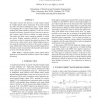Free Online Productivity Tools
i2Speak
i2Symbol
i2OCR
iTex2Img
iWeb2Print
iWeb2Shot
i2Type
iPdf2Split
iPdf2Merge
i2Bopomofo
i2Arabic
i2Style
i2Image
i2PDF
iLatex2Rtf
Sci2ools
ICASSP
2011
IEEE
2011
IEEE
Space-time adaptive processing for range-folded spread-Doppler radar clutter mitigation
This paper concerns the detection of radar targets masked by Doppler-spread surface backscatter from points beyond the radar’s maximum unambiguous range. Current methods for mitigating this so-called ”range-folded” clutter, such as reducing the pulse-repetition frequency or the use of nonrecurrent waveforms, typically involve some loss in the useable Doppler space fraction available for target detection. This paper uses blind source separation methods to exploit the known Doppler separation afforded by non-recurrent waveforms in order to estimate the spatial wavefront of the clutter across a linear receive array. Spatial adaptive processing using this estimated wavefront is then used to suppress range-folded clutter without sacrificing usable Doppler space. Simulation results are presented which quantify performance in terms of SCNR gain achieved.
Doppler Space | Doppler Space Fraction | ICASSP 2011 | Maximum Unambiguous Range | Signal Processing |
| Added | 20 Aug 2011 |
| Updated | 20 Aug 2011 |
| Type | Journal |
| Year | 2011 |
| Where | ICASSP |
| Authors | William W. Lee, Jeffrey L. Krolik |
Comments (0)

